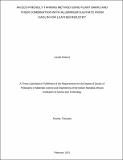| dc.description.abstract | Chrome tanning has remained the most preferred tanning method worldwide in the leather
industry because it produces leather of a high quality with all the desired features. However,
environmental concerns of chromium shifted the focus of current research to chrome-free and
greener chemical processing options. When used in combination with some eco-friendly metal
salts, vegetable tannins are environmentally safe and manageable, while producing excellent
quality leather, bearing shrinkage temperature above 100 °C as that of chromium tanned leather.
As such, shortage of vegetable tannin supply requires characterization of non-commercialized
sources locally available in Tanzania for cottage tanneries. In the present work, vegetable tannins
from the stem barks of local plants namely Acacia mearnsii (A. mearnsii), Acacia xanthophloea
(A. xanthophloea), Euclea divinorum (E. divinorum) and root barks of Euclea racemosa (E.
racemosa) were prepared using a simple extraction technique at 30-80 °C. Extract yield, tannin,
total flavonoid and phenolic content, cross-linking ability as well as properties of the tanned
leather were determined. Results indicated that even at low temperature (50 °C) the barks yield
vegetable tannins with features similar to that of a commercialized source of tannin. Euclea
racemosa extract had low tannin, phenolic and flavonoid content and its crosslinking ability was
poor; hence, was determined as an un-suitable tannin source. Despite recording less extract
yield, tannin and other contents than that of A. mearnsii, the extract from E. divinorum bark
demonstrated a substantial tanning ability, which is attributable to its high tannin strength.
However, a broad interval between T
onset
and T
peak
of treated hide powder necessitated
combination tanning with aluminium sulphate [Al
2
(SO
4
)
3
] to lower the interval. About 2% (w/v)
aluminium oxide (Al
2
O
3
) equivalent is an optimal dose of Al
2
(SO
4
)
3
for extract pre-treatment.
Since the main source of Al
2
(SO
4
)
3
, bauxite, is diminishing in the world, an alternative source of
Al
2
(SO
4
)
3
was explored. The Al
2
(SO
4
)
3
was prepared from Kaolin of Pugu hill in Tanzania and
applied for combination tanning. The study has proven the suitability of kaolin as an alternative
source of Al
2
(SO
4
)
3
for combination tanning with vegetable tannins. Leather tanned with the
combination of the prepared Al
2
(SO
4
)
3
and vegetable tannin exhibited the shrinkage temperature
of up to 118 °C as compared to vegetable tannins alone that showed the average of 80 °C.
Mechanical strength characteristics met the standard norms. Fiber separation was good as
confirmed through microscopic studies. The study provides useful information and new insights
on accomplishing self-sustenance through available resources and an eco-friendly manufacturing
system for leather industries in Tanzania and beyond. | en_US |

